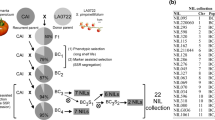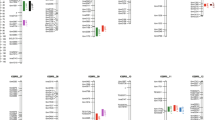Abstract
A tomato cultivar with high quality fruit and a long shelf life is a main goal in tomato breeding and it would be achieved using wild germplasm. The objective of this work was to explore the inheritance for fruit quality traits, especially fruit shelf life, in three tomato crosses using a standard Argentinean cultivar (Ca, cv ‘Caimanta’), a ripening mutant (nor, homozygous for the nor gene) of Solanum lycopersicum, and a wild cherry type (Ce, LA1385 of S. lycopersicum var. cerasiforme). The wild parent had a shorter fruit shelf life than the mutant genotype but higher than Ca. When the Ce genotype was analyzed in hybrid combination, the F1 (Ca×Ce) was similar to the wild genotype for shelf life whereas the F1 (nor × Ce) had a longer shelf life. Both F1 crosses and backcrosses to the cherry type genotype had significantly lower fruit weight than the cultivated genotypes but higher than the cherry type parent. In the F2 analysis, it was found that the inheritance underlying quality traits is complex since non allelic interactions were detected. A significant additive genetic variance was found for fruit shelf life as well as for other fruit quality traits in each cross. The genetic parameters analyzed by mean values and variances in parental, F1 and F2 and backcross generations indicated that the cross between the normal ripening cultivar and LA1385 of S. lycopersicum var. cerasiforme offers the best possibility to obtain long shelf life tomato genotypes with good fruit quality.

Similar content being viewed by others
References
Balzarini M, di Renzo J (2004) Info-Gen. Programa estadístico para datos de Mejoramiento y Genética de Poblaciones. http://www.info-gen.com.ar
Boyazoglu J (2002) Point of view on GM organisms and traditional products—genuineness or innovation? Livest Prod Sci 74:287–290
Buescher RW, Sistrunk WA, Tigchelaar EC, Ng TJ (1976) Softening, pectolytic activity, and storage-life of rin and nor tomato hybrids. Hortscience 11:603–604
Chaib J, Lecomte L, Buret M, Causse M (2006) Stability over genetic backgrounds, generations and years of quantitative trait locus (QTLs) for organoleptic quality in tomato. Theor Appl Genet 112:934–944
Cipollini ML, Levey DJ (1997) Secondary metabolites of fleshy vertebrate-dispersed fruits: adaptive hypotheses and implications for seed dispersal. Am Nat 150:346–372
Comstock RE (1996) Quantitative Genetics with special reference to Plant and Animal Breeding. Iowa State University Press/AMES, Iowa, pp 279–287
Conti S, Sanguineti MC, Toni B, Azzoni A (1988) Inheritance of quality traits in processing tomato (Lycopersicon esculentum Mill). Euphytica 37:121–127
Georgelis N, Scott JW, Baldwin EA (2006) Inheritance of high sugars from tomato accession PI 270248 and environmental variation between seasons. J Am Soc Hortic Sci 131:41–45
Grandillo S, Tanksley SD (1996) QTL analysis of horticultural traits differentiating the cultivated tomato from the closely related species Lycopersicon pimpinellifolium. Theor Appl Genet 92:935–951
Grandillo S, Ku HM, Tanksley SD (1999a) Identifying the loci responsible for natural variation in fruit size and shape in tomato. Theor Appl Genet 99:978–987
Grandillo S, Zamir D, Tanksley SD (1999b) Genetic improvement of processing tomatoes: a 20 years perspective. Euphytica 110:85–97
Jones RA, Scott SJ (1983) Improvement of tomato flavor by genetically increasing sugar and acid contents. Euphytica 32:845–855
Kearsey MJ, Pooni HS (1996) The genetical analysis of quantitative traits. Chapman and Hall, London
Kovacs K, Fray RG, Tikunov Y, Graham N, Bradley G, Seymour GB, Bovy AG, Grierson D (2009) Effect of tomato pleiotropic ripening mutations on flavour volatile biosynthesis. Phytochemistry 70:1003–1008
Lecomte L, Duffe P, Buret M, Servin B, Hospital F, Causse M (2004) Marker-assisted introgression of five QTLs controlling fruit quality traits into three tomato lines revealed interactions between QTLs and genetic backgrounds. Theor Appl Genet 109:658–668
Lippman Z, Tanksley SD (2001) Dissecting the genetic pathway to extreme fruit size in tomato using a cross between the small-fruited wild species Lycopersicon pimpinellifolium and L. esculentum var. Giant Heirloom. Genetics 158:413–422
Lower RL, Thompson AE (1967) Inheritance of acidity and solids content of small-fruited tomatoes. Proc Am Soc Hortic Sci 91:486–494
Lynch M, Walsh B (1998) Genetics and analysis of quantitative traits. Sinauer Associates, Inc., Sunderland, Massachusetts (USA)
Matas AJ, Gapper NE, Chung MY, Giovannoni JJ, Rose JKC (2009) Biology and genetic engineering of fruit maturation for enhanced quality and shelf-life. Curr Opin Biotechnol 20:197–203
McGlasson WB, McBride RL, Best DJ, Sumeghy JB, Morris LL (1983) Yield and evaluation of F1 tomato hybrids incorporating the non-ripening nor gene. Aust J Exp Agric Anim Husb 23:106–112
Meli VS, Ghosh S, Prabha TN, Chakraborty N, Chakraborty S, Datta A (2010) Enhancement of fruit shelf life by suppressing N-glycan processing enzymes. Proc Natl Acad Sci USA 107:2413–2418
Moore S, Vrebalov J, Payton P, Giovannoni J (2002) Use of genomics tools to isolate key ripening genes and analyse fruit maturation in tomato. J Exp Bot 53:2023–2030
Mutschler MA, Wolfe DW, Cobb ED, Yourstone KS (1992) Tomato fruit-quality and shelf-life in hybrids heterozygous for the alc ripening mutant. Hortscience 27:352–355
Poysa V (1993) Use of Lycopersicon-cheesmanii and L-chmielewskii to increase dry-matter content of tomato fruit. Can J Plant Sci 73:273–279
Pratta GR, Zorzoli R, Picardi LA (2003) Diallel analysis of production traits among domestic, exotic and mutant germplasms of Lycopersicon. Genet Mol Res 2:206–213
Qaim M (2009) The economics of genetically modified crops. Annu Rev Resour Econ 1:665–693
Rick CM (1979) Biosystematic studies in Lycopersicon and closely related species of Solanum. In: Hawkes JG, Lester RN, Skelding AD (eds) The biology and taxonomy of the Solanaceae. Academic Press, New York, pp 667-678
Rodriguez GR, Pratta GR, Zorzoli R, Picardi LA (2005) Transgressive segregation for fruit quality traits in a cross between exotic and mutant genotypes of Lycopersicon. N Z J Crop Hortic Sci 33:373–379
Rodriguez GR, Pratta GR, Zorzoli R, Picardi LA (2006) Recombinant lines obtained from an interspecific cross between Lycopersicon species selected by fruit weight and fruit shelf life. J Am Soc Hortic Sci 131:651–656
Saladie M, Matas AJ, Isaacson T, Jenks MA, Goodwin SM, Niklas KJ, Ren XL, Labavitch JM, Shackel KA, Fernie AR, Lytovchenko A, O’Neill MA, Watkins CB, Rose JKC (2007) A reevaluation of the key factors that influence tomato fruit softening and integrity. Plant Physiol 144:1012–1028
Saliba-Colombani V, Causse M, Langlois D, Philouze J, Buret M (2001) Genetic analysis of organoleptic quality in fresh market tomato. 1. Mapping QTLs for physical and chemical traits. Theor Appl Genet 102:259–272
Schauer N, Zamir D, Fernie AR (2005) Metabolic profiling of leaves and fruit of wild species tomato: a survey of the Solanum lycopersicum complex. J Exp Bot 56:297–307
Schuelter AR, Finger FL, Casali VWD, Brommonschenkel SH, Otoni WC (2002) Inheritance and genetic linkage analysis of a firm-ripening tomato mutant. Plant Breeding 121:338–342
Shapiro SS, Wilk MB (1965) An analysis of variance test for normality (complete samples). Biometrika 52:591–611
Simonne AH, Behe BK, Marshall MM (2006) Consumers prefer low-priced and high-lycopene-content fresh-market tomatoes. HortTechnology 16:674–681
Smith CJS, Watson CF, Ray J, Bird CR, Morris PC, Schuch W, Grierson D (1988) Antisense RNA inhibition of polygalacturonase gene-expression in transgenic tomatoes. Nature 334:724–726
Snedecor GW (1956) Statistical methods applied to experiments in agriculture and biology/by George W. Snedecor. In: Iowa State College Press, Ames, c1956
Thompson AJ, Tor M, Barry CS, Vrebalov J, Orfila C, Jarvis MC, Giovannoni JJ, Grierson D, Seymour GB (1999) Molecular and genetic characterization of a novel pleiotropic tomato-ripening mutant. Plant Physiol 120:383–389
Tigchelaar EC (1986) Tomato breeding. In: Basset MJ (ed) Breeding vegetable crops. Westport, CT, USA. AVI Publishing Company, Inc. p 135–170
Tigchelaar EC, McGlasson WB, Buescher RW (1978) Genetic-regulation of tomato fruit ripening. Hortscience 13:508–513
Yousef GG, Juvik JA (2001) Evaluation of breeding utility of a chromosomal segment from Lycopersicon chmielewskii that enhances cultivated tomato soluble solids. Theor Appl Genet 103:1022–1027
Zamir D (2001) Improving plant breeding with exotic genetic libraries. Nat Rev Genet 2:983–989
Zorzoli R, Pratta GR, Picardi LA (2000) Genetic variability for the tomato fruit’s shelf-life and weight in F-3 families derived from an interspecific hybrid. Pesqui Agropecu Bras 35:2423–2427
Acknowledgments
We thank TGRC, University of California, Davis, CA for kindly providing seeds of the accession LA1385 of S. lycopersicum var. cerasiforme. We thank Jennifer Moyseenko for reviewing the manuscript. This work was supported by Agencia Nacional de Promoción Científica y Tecnológica.
Author information
Authors and Affiliations
Corresponding author
Rights and permissions
About this article
Cite this article
Rodríguez, G.R., Pratta, G.R., Liberatti, D.R. et al. Inheritance of shelf life and other quality traits of tomato fruit estimated from F1’s, F2’s and backcross generations derived from standard cultivar, nor homozygote and wild cherry tomato. Euphytica 176, 137–147 (2010). https://doi.org/10.1007/s10681-010-0241-9
Received:
Accepted:
Published:
Issue Date:
DOI: https://doi.org/10.1007/s10681-010-0241-9




